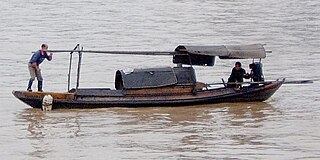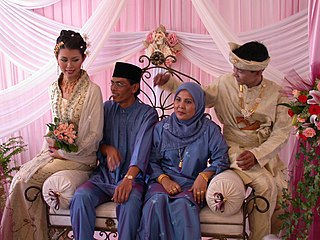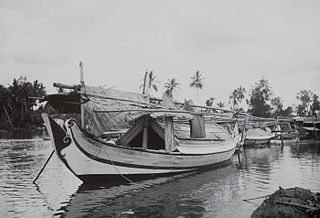
A sampan is a relatively flat-bottomed Chinese and Malay wooden boat. Some sampans include a small shelter on board and may be used as a permanent habitation on inland waters. The design closely resembles Western hard chine boats like the scow or punt. Sampans are generally used for transportation in coastal areas or rivers and are often used as traditional fishing boats. It is unusual for a sampan to sail far from land, as they do not have the means to survive rough weather.

Malay Singaporeans are Singaporeans of Malay ancestry, including those from the Malay Archipelago. They constitute approximately 13.5% of the country's citizens, making them the second largest ethnic group in Singapore. Under the Constitution of Singapore, they are recognised by the government as the indigenous people of the country, with Malay as the national language of Singapore.

The Orang Laut are several seafaring ethnic groups and tribes living around Singapore, peninsular Malaysia and the Indonesian Riau Islands. The Orang Laut are commonly identified as the Orang Seletar from the Straits of Johor, but the term may also refer to any Malayic-speaking people living on coastal islands, including those of Mergui Archipelago islands of Myanmar and Thailand, commonly known as Moken.
A kolae boat is a traditional fishing boat used in the lower southern provinces of Thailand and eastern coast of peninsular Malaysia.

Literally, the word pinisi refers to a type of rigging of Indonesian sailing vessels. A pinisi carries seven to eight sails on two masts, arranged like a gaff-ketch with what is called 'standing gaffs' — i.e., unlike most Western ships using such a rig, the two main sails are not opened by raising the spars they are attached to, but the sails are 'pulled out' like curtains along the gaffs which are fixed at around the centre of the masts.

Paraw are various double outrigger sail boats in the Philippines. It is a general term and thus can refer to a range of ship types, from small fishing canoes to large merchant lashed-lug plank boats with two outriggers (katig) propelled by sails

Tongkang or "Tong'kang" refers to several type of boats used to carry goods along rivers and shoreline in Maritime Southeast Asia. One of the earliest record of tongkang has a background of 14th century, being mentioned in Malay Annals which was composed no earlier than 17th century. One passage mentioned it as being used by Majapahit empire during the 1350 attack on Singapura.

Orang Seletar are one of the 18 Orang Asli ethnic groups in Malaysia. They are classified under the Proto-Malay people group, which forms the three major people group of the Orang Asli. The Orang Seletar are also considered as part of the Orang Laut, natives of the Straits of Johor; separating Singapore from Peninsula Malaysia.

Padewakangs were traditional boats used by the Bugis, Mandar, and Makassar people of South Sulawesi. Padewakangs were used for long-distance voyages serving the south Sulawesi kingdoms.

Perahu Mayang or simply mayang is a type of fishing boat from Java, Indonesia. This type of boat is used mainly for fishing and trading. Historically, this indigenous vessel is also favored by European skippers and private merchants for trading in East Indies: 50% of them were using mayang and pencalang. It is mostly used in northern coast of Java. The major production site is in Rembang, Central Java.

Golekan is a type of traditional boat from Madura, Indonesia. They once plied as far as Singapore, where they are referred to as Madurese traders. In the present this type of boat is only known locally, especially near Bangkalan in Western Madura and around the Kangean islands.

Palari is a type of Indonesian sailing vessel from South Sulawesi. It was mainly used by the people of Ara and Lemo Lemo, for transporting goods and people. This vessel is rigged with pinisi rig, which often makes it better known as "Pinisi" instead of its name. In Singapore, palari is known as "Makassartrader".

A jongkong is a type of dugout canoe from Maritime Southeast Asia. Jongkong was the simplest boat from Riau-Lingga area, and can be found widely though in small numbers throughout the area. The first record of jongkong comes from the Malay Annals, being used by Majapahit empire during the first Majapahit attack on Singapura (1350) and during the fall of Singapura (1398).

Perahu payang or simply payang is a traditional Malay open fishing boat. They are usually found in Terengganu, and to a lesser extent, Kelantan, Pahang, and Johor coasts. A few examples normally come down to Singapore to operate during the period of the north-east monsoon in the South China Sea.

Jukung tambangan is a traditional boat made by the Banjar people of South Kalimantan. They are mainly used for riverine transportation. It is already present at least since mid-18th century. They were not seen anymore in Banjarmasin ca. 1950s and around the 1970s on the Nagara River, Hulu Sungai Selatan Regency.

A lancang is a type of sailing ship from Maritime Southeast Asia. It is used as warship, lighter, and as royal ship, particularly used by the people of Sumatran east coast, but can also be found in the coast of Kalimantan.

Bajak is a type of sailing prahu of the Dayak people of Borneo. It is propelled by both sail and oars. The bajak has a sharp but hollow bow, with projection at top. It has large square stern which projects at the sides of the hull and supported by two strong beams. On the side of the vessel are projecting open galleries for oarsmen. Bajak has two mast with lug rig, and a bowsprit which support headsails. The sail of bajak is made of cotton. It has a large deckhouse between the foremast and mainmast, a hatchway is present abaft the mainmast. The name may have originated from Malay word bajak means "plow", or membajak, "to plow". This prahu may have been used by Sea Dayak for use in piracy owing to its double type of propulsion which is very common amongst pirate prahu of the region, and may have influenced the Javanese word bajak, which means hijack or piracy. Javanese word bajak laut means sea pirate.

Banting is a traditional boat from Aceh, Indonesia. It is also used in other areas near Malacca strait, such as Johor, where they are called "fast boat". Eredia's account of Malacca (1613) described banting of Ujontana as a kind of skiff, smaller than jalea, carrying oars and 2 masts, with 2 rudders, and used for naval warfare.

Austronesian vessels are the traditional seafaring vessels of the Austronesian peoples of Taiwan, Maritime Southeast Asia, Micronesia, coastal New Guinea, Island Melanesia, Polynesia, and Madagascar. They also include indigenous ethnic minorities in Vietnam, Cambodia, Myanmar, Thailand, Hainan, the Comoros, and the Torres Strait Islands.


























